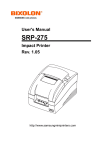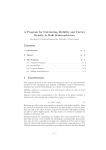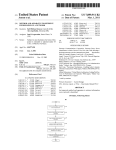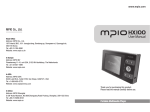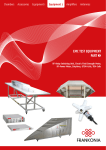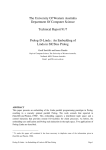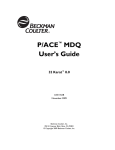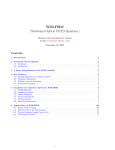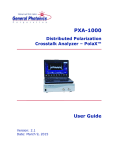Download User`s Manual for UGKS1D and UGKS2D Codes
Transcript
User’s Manual for UGKS1D and UGKS2D Codes Ruijie Wang and Kun Xu August 10, 2012 c 2012 Ruijie Wang, Kun Xu Copyright Permission is granted to copy, distribute and/or modify this document under the terms of the GNU Free Documentation License, Version 1.3 or any later version published by the Free Software Foundation; with no Invariant Sections, no Front-Cover Texts, and no Back-Cover Texts. A copy of the license is included in the section entitled GNU Free Documentation License Contents 1 Unified Gas-Kinetic Scheme 1.1 Model equation . . . . . . . . . . . . . . . 1.2 Solution algorithm . . . . . . . . . . . . . 1.3 Nondimensionalization . . . . . . . . . . . 1.4 Time step and reconstruction . . . . . . . 1.5 The algorithm . . . . . . . . . . . . . . . . 1.5.1 The calculation of interface fluxes 1.5.2 The numerical procedure . . . . . 1.6 Update cell averaged value . . . . . . . . . 1.7 Boundary condition . . . . . . . . . . . . . . . . . . . . . . . . . . . . . . . . . . . . . . . . . . . . . . . . . . . . . . . . . . . . . . . . . . . . . . . . . . . . . . . . . . . . . . . . . . . . . . . . . . . . . . . . . . . . . . . . . . . . . . . . . . . . . . . . . . . . . . . . . . . . . . . . . . . . . . . . . . . . . . . . . . . . . . . . . . . . . . . . . . . . . . . . . . . . . . . . . . . . . . . . . . . . . . . . . . . . . . . . . . . . . . . . . . . . . . . . . . . . . . . . . . . . . . 1 . 1 . 2 . 3 . 4 . 4 . 5 . 6 . 9 . 10 2 UGKS Codes 2.1 Usage . . . . . . . . . . . . . . . 2.1.1 Compiling . . . . . . . . . 2.1.2 Running . . . . . . . . . . 2.1.3 Other information . . . . 2.2 UGKS1D Code . . . . . . . . . . 2.3 UGKS2D Code . . . . . . . . . . 2.3.1 Differences with 1D . . . 2.3.2 Lid-driven cavity problem 2.3.3 Other information . . . . . . . . . . . . . . . . . . . . . . . . . . . . . . . . . . . . . . . . . . . . . . . . . . . . . . . . . . . . . . . . . . . . . . . . . . . . . . . . . . . . . . . . . . . . . . . . . . . . . . . . . . . . . . . . . . . . . . . . . . . . . . . . . . . . . . . . . . . . . . . . . . . . . . . . . . . . . . . . . . . . . . . . . . . . . . . . . . . . . . . . . . . . . . . . . . . . . . . . . . . . . . . . . . . . . . . . . . . . . . . . . . . . . . . . . . . . . . . . . . . . . . . 11 11 11 12 12 12 13 13 14 15 GNU Free Documentation License 1. APPLICABILITY AND DEFINITIONS . . . . . . . . . 2. VERBATIM COPYING . . . . . . . . . . . . . . . . . . 3. COPYING IN QUANTITY . . . . . . . . . . . . . . . . 4. MODIFICATIONS . . . . . . . . . . . . . . . . . . . . . 5. COMBINING DOCUMENTS . . . . . . . . . . . . . . . 6. COLLECTIONS OF DOCUMENTS . . . . . . . . . . . 7. AGGREGATION WITH INDEPENDENT WORKS . . 8. TRANSLATION . . . . . . . . . . . . . . . . . . . . . . 9. TERMINATION . . . . . . . . . . . . . . . . . . . . . . 10. FUTURE REVISIONS OF THIS LICENSE . . . . . . 11. RELICENSING . . . . . . . . . . . . . . . . . . . . . . ADDENDUM: How to use this License for your documents . . . . . . . . . . . . . . . . . . . . . . . . . . . . . . . . . . . . . . . . . . . . . . . . . . . . . . . . . . . . . . . . . . . . . . . . . . . . . . . . . . . . . . . . . . . . . . . . . . . . . . . . . . . . . . . . . . . . . . . . . . . . . . . . . . . . . . . . . . . . . . . . . . . . . . . . . . . . . . . . . . . . . . . . . . . . . . . . . . . . . . . . . . . . . . . . . . . . . . . . . . . . . . . . . . . . . . . . . . . . . . . . . . . . . . . . . . . . . . . . 17 17 18 18 19 20 20 21 21 21 21 22 22 . . . . . . . . . . . . . . . . . . . . . . . . . . . . . . . . . . . . . . . . . . . . . Appendix A: Moments of Maxwellian distribution function 23 Bibliography 25 i ii Chapter 1 Unified Gas-Kinetic Scheme This chapter describes the Unified Gas-Kinetic Scheme presented in [1, 2]. This is a 1D formulation. The 2D formulation with directional splitting is presented in [3], which can be extended to develop a truly multidimensional formulation, see[4]. 1.1 Model equation The model equation is the BGK-Shakhov model. In one dimensional case, ∂f f+ − f ∂f +u = , ∂t ∂x τ (1.1) where f is the distribution function, u is particle velocity, τ = µ/p is particle collision time, µ is the dynamic viscosity, p is the pressure and f + is the modified equilibrium distribution function. The modified equilibrium distribution is given by, 2 c f + = g 1 + (1 − Pr)c · q − 5 /(5pRT ) = g + g + , RT (1.2) where g is the Maxwellian distribution, Pr is the Prandtl number, c is the random velocity, q is heat flux, R is gas constant and T is the temperature. The Maxwellian distribution for 1D problem is, K+1 2 2 2 λ g=ρ e−λ((u−U) +ξ ) , π (1.3) where ρ is density, λ = m/2kT , m is molecule mass, k is Boltzmann constant, U is the macroscopic 2 . For example, a velocity, K is the number of internal degree of freedom and ξ 2 = ξ12 + ξ22 ... + ξK monatomic gas at 1D problem has K = 2 to account for the motion in y, z direction, and ξ 2 = v 2 + w2 , where v, w are particle velocity in y, z direction. The relation between K and the ratio of specific heat is, γ= K +3 . K +1 (1.4) The dynamic viscosity can be calculated from Sutherland’s law or hard-sphere(HS)/variable hard-sphere model(VHS), ω T , (1.5) µ = µref Tref 1 where µref is the reference viscosity and Tref is the reference temperature, ω is the index related to HS or VHS model. The collision term meets the requirement of conservative constraint or compatibility condition Z (f + − f )ψdΞ = 0, (1.6) where ψ = (1, u, 1/2(u2 + ξ 2 ))T is the collision invariants and dΞ = dudξ. The macroscopic variables can be calculated via, Z ρ W = ρU = ψf dΞ, ρE q= (1.7) p= 1 3 [(u − U )2 + ξ 2 ]f dΞ, (1.8) 1 2 (u − U )[(u − U )2 + ξ 2 ]f dΞ, (1.9) where ρE is total energy. Z Z An integral solution of the BGK-Shakhov model can be constructed by the method of characteristics[5], 1 f (x, t, u, ξ) = τ Z t n ′ f + (x′ , t′ , u, ξ)e−(t−t )/τ dt′ + e−(t−t tn )/τ f0n (x − u(t − tn ), tn , u, ξ), (1.10) where x′ = x − u(t − t′ ) is the particle trajectory and f0n is the initial gas distribution function at tn . 1.2 Solution algorithm For the numerical computation, in addition to the discretization of physical space and time, the velocity space is also discretized. That is, the distribution function is for some discrete particle velocities instead of continuous velocity space from −∞ to ∞ as in [6]. Then the moments of the non-equilibrium distribution function are calculated through numerical integration(the moments of equilibrium distribution are still calculated using analytical integration). The discretization of the velocity space is determined by the choice of numerical integration method. In the finite volume approach, if trapezoidal rule is used for the approximation of collision term, Eq. 1.1 becomes, ! Z tn+1 +(n+1) +(n) n+1 n − fi,k fi,k − fi,k 1 ∆t fi,k n+1 n , (1.11) + fi,k = fi,k + (fi−1/2 − fi+1/2 )dt + ∆x tn 2 τ n+1 τn n+1 n where fi,k and fi,k are cell averaged distribution function of the i-th cell and k-th discrete particle n velocity uk at time t and tn+1 respectively, ∆x is the cell length and ∆t is the time step, fi−1/2 and +(n) +(n+1) fi+1/2 are the fluxes of the distribution function across the cell interface, fi,k and fi,k are modified equilibrium distribution, τ n and τ n+1 are particle collision time. Multiplying the collision invariants to Eq. 1.11 and make integration over the velocity space, the evolution of conservative flow variables becomes, Win+1 = Win + where F = Z tn+1 tn Z 1 (Fi−1/2 − Fi+1/2 ), ∆x ψf dΞdt. 2 (1.12) In order to update the distribution function in Eq. 1.11, there are three unknowns to be obtained: the interface gas distribution function f , the modified equilibrium distribution f +(n+1) and collision time τ n+1 at the next time level. The flux f is calculated using the integral solution Eq. 1.10 at the cell interface. Since f +(n+1) and τ n+1 have one-to-one correspondence to the macroscopic variables, they are obtained by using the updated conservative variables in Eq. 1.12. In order to remove the dependence of distribution functions on the internal degree of freedom ξ, the reduced distribution function [7, 8] is used in real computation, which is defined as, Z ∞ Z ∞ h= f dξ, b = ξ 2 f dξ, (1.13) −∞ −∞ and the reduced modified equilibrium distributions are, h+ = H + H + , b+ = B + B + , where the corresponding reduced Maxwellian distribution g becomes, 1/2 Z ∞ Z ∞ λ K −λ(u−U)2 H= gdξ = ρ , B= e ξ 2 gdξ = H, π 2λ −∞ −∞ and the corresponding terms related to g + becomes, Z ∞ 4(1 − Pr)λ2 g + dξ = H+ = (u − U )q(2λ(u − U )2 + K − 5)H, 5ρ −∞ Z ∞ 4(1 − Pr)λ2 B+ = ξ 2 g + dξ = (u − U )q(2λ(u − U )2 + K − 3)B, 5ρ −∞ (1.14) (1.15) Then the update of f using Eq. 1.11 becomes two similar equations for the update of h and b, respectively. The overview flow chart of the solution algorithm in one iteration is shown in Figure. 1.1. calculate time step (reconstruction) calculate slop of h,b in each physical cell calculate interface flux of h, b, W calculate W n+1 calculate h+(n+1) , b+(n+1) and τ n+1 calculate hn+1 , bn+1 Figure 1.1: solution algorithm in one iteration 1.3 Nondimensionalization In the program, the following nondimensionalization is used, t ux x ρ T p , ûx = , x̂ = , ρ̂ = , T̂ = , p̂ = , 2 t∞ C∞ L∞ ρ∞ T∞ ρ∞ C∞ h b E µ q , ĥ = , b̂ = , Ê = 2 , µ̂ = , q̂ = 3 ρ∞ C∞ ρ∞ /C∞ ρ∞ C∞ ρ∞ C∞ L∞ t̂ = 3 The free stream variables are related through, C∞ = p L∞ 2 2RT∞ , t∞ = , λ∞ = 1/C∞ . C∞ In the following, all variables are nondimensionalized, but we will drop the ”ˆ” for simplicity. After nondimensionalization and using the reduced distribution function, the expressions for macroscopic variables become, Z X ρ = hdu = αk hk , Z X ρU = hudu = αk hk uk , (1.16) Z Z X 1 1 X ρE = αk hk u2k + αk bk , hu2 du + bdu = 2 2 K +1 p= 2 Z (u − U )2 hdu + Z bdu = X αk (uk − U )2 hk + X Z Z 1 2 (u − U )(u − U ) hdu + (u − U )bdu q= 2 i X 1 hX αk (uk − U )(uk − U )2 hk + αk (uk − U )bk , = 2 αk bk , (1.17) (1.18) where αk is the weight of the numerical integration at the k-th particle velocity. The summation is over all the discrete particle velocity. The equation of state is, p= 1.4 1 ρT, 2 1 . T (1.19) ∆x , |U | + c (1.20) λ= Time step and reconstruction The time step is determined by the CFL condition ∆t = CFL where CFL is the CFL number, c is the speed of sound. The macroscopic velocity |U | + c can also be replaced by max(|u|). In the program, the van Leer limiter is used for the reconstruction. For example, the slope of h at the i-th cell and k-th particle velocity is, h σi,k = (sign(s1 ) + sign(s2 )) |s1 ||s2 | , |s1 | + |s2 | where s1 = (hi,k − hi−1,k )/(xi − xi−1 ), s2 = (hi+1,k − hi,k )/(xi+1 − xi ). The slope of b is calculated in the same way. 1.5 The algorithm Take the interface xi+1/2 = 0 at tn = 0 as example. 4 (1.21) 1.5.1 The calculation of interface fluxes Here the original distribution function is used for illustration. From Eq. 1.10, the integral solution at the cell interface is, Z ′ 1 t + ′ ′ f (0, t, uk , ξ) = f (x , t , uk , ξ)e−(t−t )/τ dt′ + e−t/τ f0 (−uk t, 0, uk , ξ). (1.22) τ 0 The initial distribution function around the interface f0 is, ( L fi+1/2,k + σi,k x, x 6 0, f0 (x, 0, uk , ξ) = R fi+1/2,k + σi+1,k x, x > 0, (1.23) L R where fi+1/2,k , fi+1/2,k are the reconstructed initial distribution functions at the left and right side of the interface. The Maxwellian distribution around the interface in f + is approximated by Taylor expansion, g(x, t, u, ξ) = g0 [1 + (1 − H[x])aL x + H[x]aR x + At], (1.24) where g0 is the Maxwellian distribution at x = 0, t = 0 and H[x] is the Heaviside function ( 0, x < 0, H[x] = 1, x > 0. aL , aR and A have the same form [6], 1 a = a1 + a2 u + a3 (u2 + ξ 2 ), 2 where a1 , a2 , a3 are local constants. Inserting Eq. 1.23 and Eq. 1.24 into Eq. 1.22, one obtains, f (0, t, uk , ξ) =(1 − e−t/τ )(g0 + g + ) + (τ (−1 + e−t/τ ) + te−t/τ )(aL H[uk ] + aR (1 − H[uk ]))uk g0 + τ (t/τ − 1 + e−t/τ )Ag0 +e −t/τ L ((fi+1/2,k − uk tσi,k )H[uk ] + =g̃i+1/2,k + f˜i+1/2,k , R (fi+1/2,k (1.25) − uk tσi+1,k )(1 − H[uk ])) where g̃i+1/2,k is the first three terms related to equilibrium distribution, f˜i+1/2,k is the last term related to the initial non-equilibrium distribution. Here g0 or W0 in Eq. 1.24 can be obtained by applying the compatibility condition at x = 0, t = 0, Z (f + − f )|x=0,t=0 ψdΞ = 0, which gives, W0 = Z g0 ψdΞ = Z f0 (0, 0, uk , ξ)ψdΞ. Then, aL , aR , A are obtained from the slope of conservative variables, L Z R Z ∂W ∂W L = a g0 ψdΞ, = aR g0 ψdΞ, ∂x ∂x Z ∂W = Ag0 ψdΞ. ∂t 5 (1.26) (1.27) (1.28) The time derivative of W can be calculated via the compatibility condition, Z d + (f − f )ψdΞ = 0, dt x=0,t=0 which gives, 1.5.2 ∂W =− ∂t Z aL H[u] + aR (1 − H[u]) ug0 ψdΞ. (1.29) The numerical procedure The flow chart of the numerical procedure is shown in Figure. 1.2 From reconstruction, obtain hi+1/2,k , bi+1/2,k from Eq. 1.26, obtain W0 from Eq. 1.27, obtain aL , aR from Eq. 1.29, obtain ∂W /∂t from Eq. 1.28, obtain A calculate collision time and some time integration terms calculate flux of conservative variables related to g0 calculate flux of conservative variables related to g + and f0 calculate flux of distribution functions Figure 1.2: interface flux calculation Reconstruct initial distribution R Take h as example. Since we take value from hL i+1/2,k only if uk > 0 and take value from hi+1/2,k only if uk < 0 (see Eq. 1.25), there is no need to store the left and right values separately. We define the variable, hi+1/2,k = ( h hi,k + (xi+1/2 − xi )σi,k , uk > 0, h hi+1,k − (xi+1 − xi+1/2 )σi+1,k , uk < 0, and similarly, h σi+1/2,k = ( h σi,k , uk > 0, h σi+1,k , uk < 0. In the program, they are written as, h h h H[uk ] + σi+1,k (1 − H[uk ]), σi+1/2,k = σi,k and, h h )(1 − H[uk ]). hi+1/2,k = (hi,k + (xi+1/2 − xi )σi,k )H[uk ] + (hi+1,k − (xi+1 − xi+1/2 )σi+1,k 6 Calculate W0 W0 is calculated from Eq. 1.16, with hk = hi+1/2,k , bk = bi+1/2,k . Then the primary variables is obtained from the relation (the expression for λ below only holds for equilibrium state), ρ0 = ρ0 , U0 = ρ0 U 0 , ρ0 λ0 = (K + 1)ρ0 . 4 ρ0 E0 − 21 ρ(U02 + V02 ) The heat flux is calculated by Eq. 1.18, with hk = hi+1/2,k , bk = bi+1/2,k , U = U0 . Calculate aL , aR The macroscopic slope is approximated by, ∂W ∂x L ≈ W0 − Wi , xi+1/2 − xi ∂W ∂x R ≈ Wi+1 − W0 , xi+1 − xi+1/2 and the three components of aL , aR are calculated from, ∂ρE ∂ρU K + 1 ∂ρ 4λ20 , 2 + U02 − − 2U0 (K + 1)ρ0 ∂x 2λ0 ∂x ∂x 2λ0 ∂ρU ∂ρ a2 = − U 0 a3 , − U0 ρ0 ∂x ∂x K+1 1 1 ∂ρ U02 + a3 . − U 0 a2 − a1 = ρ0 ∂x 2 2λ0 a3 = (1.30) Calculate ∂W /∂t and A From Eq. 1.29, the time derivative of W is calculated from, ∂W = −ρ0 < aL uψ >>0 + < aR uψ ><0 , ∂t where < ... > is the moments of Maxwellian distribution function. The detail definition and calculation can be found in [6] and also Appendix A: Moments of Maxwellian distribution function. A is calculated in the same way as aL , aR using Eq. 1.30. Calculate collision time and some time integration terms From Eq. 1.5 and Eq. 1.19, the collision time is, τ= 2λ1−ω 0 µ∞ . ρ0 7 Some time integrals used in the evaluation of flux are listed below, M t4 = M t5 = Z tn+1 e−t/τ dt = τ (1 − e−∆t/τ ), tn Z tn+1 te−t/τ dt = −τ ∆te−∆t/τ + τ M t4 , tn M t1 = M t2 = M t3 = Z tn+1 (1 − e−t/τ )dt = ∆t − M t4 , tn Z tn+1 (τ (−1 + e−t/τ ) + te−t/τ )dt = −τ M t1 + M t5 , tn Z tn+1 τ (t/τ − 1 + e−t/τ )dt = tn 1 2 ∆t − τ M t1 . 2 Calculate the flux of conservative variables related to g0 R tn+1 R Theoretically, tn g̃i+1/2 uψdΞdt can be calculated analytically. But the integration related to g + is too complex, and will be calculated with numerical integration. Only the terms related to g0 will be integrated analytically here. Fg0 = M t1 ρ0 < uψ > +M t2 ρ0 < aL u2 ψ >>0 + < aR u2 ψ ><0 + M t3 ρ0 < Auψ > Calculate the flux of conservative variables related to g + and f0 First evaluate Hk , Bk corresponding to g0 by Eq. 1.14, Hk = ρ 0 λ0 π 1/2 2 e−λ0 (uk −U0 ) , Bk = K Hk , 2λ0 and then evaluate Hk+ , Bk+ corresponding to g + by Eq. 1.15, 4(1 − Pr)λ20 (uk − U0 )q(2λ0 (uk − U0 )2 + K − 5)Hk , 5ρ0 4(1 − Pr)λ20 Bk+ = (uk − U0 )q(2λ0 (uk − U0 )2 + K − 3)Bk . 5ρ0 Hk+ = The flux of conservative variables related to g + is, P + P αk u2k Hk+ Fg+ = M t1 P αk uk H . Pk + 1 3 + α u H + α u B k k k k k k 2 The flux of conservative variables related to f0 is, Ff0 = M t4 1 2 P h P αk u2k σi+1/2,k α u h k k P i+1/2,k P h αk u3k σi+1/2,k − M t5 αk u2k hi+1/2,k . P P P P 1 h b αk u3k hi+1/2,k + αk uk bi+1/2,k αk u4k σi+1/2,k + αk u2k σi+1/2,k 2 The flux of conservative variables is, Fi+1/2 = Z tn+1 tn Z fi+1/2 uψdΞdt = Fg0 + Fg+ + Ff0 . 8 Calculate the flux of distribution functions The flux of reduced distribution function h is calculated by, Z tn+1 tn h dt = fi+1/2,k Z tn+1 tn Z fi+1/2,k uk dξdt = M t1 uk (Hk + Hk+ ) 1 L 2 L H + a u H + a (u H + B ) H[uk ] + M t2 u2k aL k k 1 k 2 k k 2 3 k 1 R 2 R + M t2 u2k aR H + a u H + a (u H + B ) (1 − H[uk ]) k k k 1 2 k k 2 3 k 1 + M t3 uk A1 Hk + A2 uk Hk + A3 (u2k Hk + Bk ) 2 h + M t4 uk hi+1/2,k − M t5 u2k σi+1/2,k . The flux of reduced distribution function b is calculated by, Z tn+1 tn h fi+1/2,k dt = Z tn+1 tn Z fi+1/2,k uk dξdt = M t1 uk (Bk + Bk+ ) 1 L 2 4 L a (u B + < ξ > H ) H[uk ] + M t2 u2k aL B + a u B + k k 1 k 2 k k 2 3 k 1 R 2 R 4 B + a u B + + M t2 u2k aR a (u B + < ξ > H ) (1 − H[uk ]) k k 1 k 2 k k 2 3 k 1 + M t3 uk A1 Bk + A2 uk Bk + A3 (u2k Bk + < ξ 4 > Hk ) 2 b . + M t4 uk bi+1/2,k − M t5 u2k σi+1/2,k 1.6 Update cell averaged value The procedure is shown in Figure. 1.3 store W n and calculate H n , B n , τ n calculate W n+1 by Eq. 1.12,and H n+1 , B n+1 , τ n+1 calculate heat flux q with hn , bn , W n h+(n) , b+(n) with q, H n , B n , W n +(n+1) +(n+1) h ,b with q, H n+1 , B n+1 , W n+1 calculate hn+1 and bn+1 Figure 1.3: update cell averaged value 9 The equation for updating hn+1 and bn+1 can be obtained from Eq. 1.11, !# −1 " Z tn+1 +(n+1) +(n) hi,k − hni,k 1 ∆t hi,k ∆t n+1 n h h hi,k + , + (fi−1/2 − fi+1/2 )dt + hi,k = 1 + n+1 2τ ∆x tn 2 τ n+1 τn !# −1 " Z tn+1 +(n+1) +(n) n b b − b ∆t 1 ∆t i,k i,k i,k b b bn+1 bni,k + . + )dt + − fi+1/2 (fi−1/2 i,k = 1 + 2τ n+1 ∆x tn 2 τ n+1 τn 1.7 Boundary condition Only isothermal wall boundary condition with complete accommodation is discussed. Assuming left wall (x = 1/2). The boundary condition described here is quiet simple, the incoming distribution function is directly obtained through interpolation. This kind of boundary treatment is sufficient for Knudsen number case Kn = 0.075, 1.0, 10.0. For flow in continuum regime, one need to use the same method as the inner region to calculate the incoming distribution function and flux. in First, obtain hin k , bk by one-sided interpolation from the interior region. For example, ∆x . 2 h hin k = h1,k − σ1,k Second, calculate the density at the wall with the condition that no particle penetrating the wall, Z tn+1 tn Z ugw dΞdt + Z tn+1 tn u>0 which gives, ρw = − λw π P 1/2 P Z uf in dΞdt = 0, u<0 αk uk hin k αk uk e−λw (uk −Uw )2 , where gw , ρw , λw , Uw are the variables at the wall. The corresponding reduced Maxwellian distribution at the wall Hkw , Bkw is also obtained. Thirdly, the distribution function at the boundary interface is expressed by (same holds for bk ), hk = Hkw H[uk ] + hin k (1 − H[uk ]). Finally, the flux across the wall is calculated by, F1/2 and, P P αk uk2 hk αk uk hk = ∆t P , αk 12 u3k hk + uk bk Z Z tn+1 tn tn+1 tn h dt = ∆tuk hk , f1/2,k Fb1/2,k dt = ∆tuk bk . 10 Chapter 2 UGKS Codes 2.1 2.1.1 Usage Compiling A makefile is provided to compile the program under Linux. If you are using any IDE (e.g. Visual Studio), use the compiling function provided by the IDE. The makefile can be used to compile the two codes, UGKS1D and UGKS2D, and also this manual. There are several requirements for the makefile to work. • Fortran Compiler: either ifort or gfortran , supporting Fortran 2003 • Bash shell • Latex: only for compilation of the manual. It requires hyperref , parskip , amsmath , amssymb , fullpage , appendix , graphicx , subfigure , xcolor , listings or minted packages, and also bibtex , dvips and ps2pdf . By default, the make command will compile both UGKS1D and UGKS2D with openmp and ifort. This behavior can be changed by specifying the target and passing parameters. 1. Compile both UGKS1D and UGKS2D with openmp and ifort make 2. Only compile UGKS1D make 1D 3. Only compile UGKS2D make 2D 4. Compile both UGKS1D and UGKS2D, but WITHOUT openmp, and WITH gfortran make OMP=no FC=gfortran 5. Compile the manual make manual 6. Clean the compilation make clean The executables will be put into the bin directory, and the compiled manual.pdf will in the doc directory. 11 2.1.2 Running Just type the program name to run it under the bin directory, no input file or data is required. The code will generate two files, • *.hst : record the convergence history every 10 iterations. • *.dat : record the final result of the program. Both files are in tecplot format and will be put into current working directory. 2.1.3 Other information The comments in the program are written in doxygen format, and can be used to generate documentation of the code. But the doxygen configuration file is not included, and the documentation generation is not tested. This program uses GIT for version control, and the source repository is published on GitHub. To obtain the code via git, use the following command, git clone git://github.com/lainme/UGKS.git 2.2 UGKS1D Code Once the flow condition before the normal shock is known (upstream), the flow variables after the shock (downstream) can be calculated by normal shock relation, s M12 (γ − 1) + 2 M2 = , 2γM12 − (γ − 1) (γ + 1)M12 ρ2 = , ρ1 (γ − 1)M12 + 2 (2.1) 2γ 2 2 (1 + γ−1 T2 2 M1 )( γ−1 M1 − 1) , = γ−1 2γ T1 M12 ( γ−1 + 2 ) where M1 , ρ1 , T1 are upstream Mach number, density and temperature. M2 , ρ2 , T2 are downstream Mach number, density and temperature. For shock structure calculation, the upstream and downstream conditions are specified at the two boundaries (via ghost cell). And the flux across the interfaces are calculated through the same method described in section 1.5. In the UGKS1D code, the reference state is, L∞ = lmf p,1 , T∞ = T1 , ρ∞ = ρ1 , where lmf p,1 is the upstream mean free path. There are several important options in the code, • method output: the method to output the solution. If set to ORIGINAL , the original nondimensionalized values will be written to the result file. If set to NORMALIZE , the density will be normalized by ρ = (ρ − ρ1 )/(ρ2 − ρ1 ) and the temperature is also normalized by the same way • mu ref : the reference viscosity coefficient µ∞ , which can be specified directly or calculated through the provided function get mu . This function calculate the viscosity coefficient through, √ 5(α + 1)(α + 2) π Kn∞ , µ∞ = 4α(5 − 2ω)(7 − 2ω) 12 where α, ω are coefficients related to molecule model. The default settings in the code is for Argon shock structure calculation at Ma = 8.0, see [2]. • Argon gas with Prandlt number Pr = 2.0/3.0 and variable hard-sphere model ω = 0.72 • Mach number 8.0 • Newton-Cotes integration with 100 velocity points ranges from -15 to 15. • Computation domain is 50 times of the upstream mean free path • Cell size is half of the upstream mean free path • Output solution at t = 250 Figure. 2.1 shows the comparison of the simulated density with the experimental measurements [9] and also temperature profile . Normalized density and temperature Ma=8, =0.72 Argon shock structure 1 0.8 0.6 0.4 0.2 T (UGKS) (UGKS) (Experiment) 0 -8 -6 -4 -2 0 2 4 6 8 Figure 2.1: Argon shock structure at Ma = 8.0. 2.3 2.3.1 UGKS2D Code Differences with 1D For 2D problem, many expressions need to be slightly changed. For example, g=ρ K+2 2 2 2 2 λ e−λ((u−U) +(v−V ) +ξ ) , π where v is particle velocity in y direction, V is macroscopic velocity in y direction. The relation between K and γ becomes, γ= K +4 . K +2 The reduced Maxwellian distribution becomes (B is not changed), H= Z ∞ −∞ gdξ = ρ 2 2 λ e−λ((u−U) +(v−V ) ) . π 13 The collision invariants are ψ = (1, u, v, 1/2(u2 +v 2 +ξ 2 ))T . And the expressions for macroscopic variables are correspondingly changed. For example, the nondimensionalized pressure is calculated via, Z Z K +2 2 2 p = ((u − U ) + (v − V ) )hdu + bdu. 2 When calculating the flux, the slopes related to Maxwellian become, 1 a = a1 + a2 u + a3 v + a4 (u2 + v 2 + ξ 2 ), 2 and the components are calculated via, 4λ20 ∂ρE ∂ρU ∂ρV K + 2 ∂ρ 2 2 a4 = , 2 + U0 + V0 − − 2U0 − 2V0 (K + 2)ρ0 ∂x 2λ0 ∂x ∂x ∂x ∂ρ 2λ0 ∂ρV − V0 a4 , − V0 a3 = ρ0 ∂x ∂x 2λ0 ∂ρU ∂ρ a2 = − U 0 a4 , − U0 ρ0 ∂x ∂x k+2 1 1 ∂ρ 2 2 U0 + V0 + a4 . − U0 a2 − V0 a3 − a1 = ρ0 ∂x 2 2λ0 2.3.2 Lid-driven cavity problem The test case included in UGKS2D code is Lid-driven cavity problem[3]. The argon gas is enclosed by four walls to form a rectangular shape. The upper wall is moving in tangential direction with velocity UW , other walls are stationary. All walls are kept at a constant temperature TW , and full accommodation is assumed. The gas is initially at rest with the same temperature as the wall. Figure. 2.2 shows the schematic of the problem. UW , T W TW Argon TW TW Figure 2.2: Schematic of Lid-driven cavity problem In the code, the default test case is for TW = 273K, UW = 50m/s, Kn = lmf p /L = 0.075, where lmf p is mean free path and L is the domain length. Choose the initial condition as reference state, the settings are • Second order interpolation • VHS model for collision time and HS model for reference state 14 • Prandtl number Pr = 2.0/3.0, Knudsen number Kn∞ = 0.075 (at reference state) • TW = 1, UW = 0.15 • L = 1 with 45x45 grids • Gaussian quadrature with 28x28 velocity points Figure. 2.3 shows the result for the above setup, and compared with the DSMC solution[10]. Kn=0.075, Heat flux Kn=0.075, Temperature 275.00 274.75 274.50 274.25 274.00 273.75 273.50 273.25 273.00 272.75 272.50 0.8 0.6 0.8 0.6 Y Y 0.4 0.4 UGKS DSMC 0.2 0.2 0.2 0.4 X 0.6 0.8 0.2 (a) Temperature contour 0.4 X 0.6 0.8 (b) Heat flux K 75, Horizontal center line Kn=0.075, Vertical center line 1 0.2 UGKS DSMC 0.15 0.8 0.1 0.05 0.6 V/Uw 0 Y 0.4 -0.05 -0.1 0.2 UGKS -0.15 DSMC 0 -0.2 0 0.2 U/Uw 0.4 0.6 -0.2 0.8 (c) U-velocity along vertical center line 0 0.2 0.4 X 0.6 0.8 1 (d) V-velocity along horizontal center line Figure 2.3: Cavity flow at Kn = 0.075. In the temperature contour, the black lines are from DSMC, the white lines and background contour are from UGKS 2.3.3 Other information The Gaussian quadrature used in the code is from Table IIa of [11], which is better than Gaussian-Hermite quadrature in high Knudsen number case. But for the cavity problem with Kn >= 1, Newton-Cotes formula of 61x61 velocity grids with velocity range u, v = −4 − 4 can avoid oscillating in the solution, which happens using Gaussian quadrature and second order interpolation. For example, the setting for Newton-Cotes integration subroutine init() !variable declarations... 15 real(kind=RKD) :: umin,vmin !declare smallest discrete velocity umin = -4.0 vmin = -4.0 !largest discrete velocity. Global variables umax = 4.0 vmax = 4.0 !number of velocity points. Global variables unum = 61 vnum = 61 call init_velocity_newton(unum,umin,umax,vnum,vmin,vmax) !set the velocity space !other commands... end subroutine init TM R Core On Intel Quad Processor Q9450 (12M Cache, 2.66 GHz, 1333 MHz FSB) with openmp enabled, the computation time of the above setup is about 16 minutes (with openmp). With 65x65 physical space, the computation time is about 35 minutes. 16 GNU Free Documentation License Version 1.3, 3 November 2008 c 2000, 2001, 2002, 2007, 2008 Free Software Foundation, Inc. Copyright <http://fsf.org/> Everyone is permitted to copy and distribute verbatim copies of this license document, but changing it is not allowed. Preamble The purpose of this License is to make a manual, textbook, or other functional and useful document “free” in the sense of freedom: to assure everyone the effective freedom to copy and redistribute it, with or without modifying it, either commercially or noncommercially. Secondarily, this License preserves for the author and publisher a way to get credit for their work, while not being considered responsible for modifications made by others. This License is a kind of “copyleft”, which means that derivative works of the document must themselves be free in the same sense. It complements the GNU General Public License, which is a copyleft license designed for free software. We have designed this License in order to use it for manuals for free software, because free software needs free documentation: a free program should come with manuals providing the same freedoms that the software does. But this License is not limited to software manuals; it can be used for any textual work, regardless of subject matter or whether it is published as a printed book. We recommend this License principally for works whose purpose is instruction or reference. 1. APPLICABILITY AND DEFINITIONS This License applies to any manual or other work, in any medium, that contains a notice placed by the copyright holder saying it can be distributed under the terms of this License. Such a notice grants a world-wide, royalty-free license, unlimited in duration, to use that work under the conditions stated herein. The “Document”, below, refers to any such manual or work. Any member of the public is a licensee, and is addressed as “you”. You accept the license if you copy, modify or distribute the work in a way requiring permission under copyright law. A “Modified Version” of the Document means any work containing the Document or a portion of it, either copied verbatim, or with modifications and/or translated into another language. A “Secondary Section” is a named appendix or a front-matter section of the Document that deals exclusively with the relationship of the publishers or authors of the Document to the Document’s overall subject (or to related matters) and contains nothing that could fall directly within that overall subject. (Thus, if the Document is in part a textbook of mathematics, a Secondary Section may not explain any mathematics.) The relationship could be a matter of historical connection with the subject or with related matters, or of legal, commercial, philosophical, ethical or political position regarding them. The “Invariant Sections” are certain Secondary Sections whose titles are designated, as being those of Invariant Sections, in the notice that says that the Document is released under this License. If a section 17 does not fit the above definition of Secondary then it is not allowed to be designated as Invariant. The Document may contain zero Invariant Sections. If the Document does not identify any Invariant Sections then there are none. The “Cover Texts” are certain short passages of text that are listed, as Front-Cover Texts or BackCover Texts, in the notice that says that the Document is released under this License. A Front-Cover Text may be at most 5 words, and a Back-Cover Text may be at most 25 words. A “Transparent” copy of the Document means a machine-readable copy, represented in a format whose specification is available to the general public, that is suitable for revising the document straightforwardly with generic text editors or (for images composed of pixels) generic paint programs or (for drawings) some widely available drawing editor, and that is suitable for input to text formatters or for automatic translation to a variety of formats suitable for input to text formatters. A copy made in an otherwise Transparent file format whose markup, or absence of markup, has been arranged to thwart or discourage subsequent modification by readers is not Transparent. An image format is not Transparent if used for any substantial amount of text. A copy that is not “Transparent” is called “Opaque”. Examples of suitable formats for Transparent copies include plain ASCII without markup, Texinfo input format, LaTeX input format, SGML or XML using a publicly available DTD, and standard-conforming simple HTML, PostScript or PDF designed for human modification. Examples of transparent image formats include PNG, XCF and JPG. Opaque formats include proprietary formats that can be read and edited only by proprietary word processors, SGML or XML for which the DTD and/or processing tools are not generally available, and the machine-generated HTML, PostScript or PDF produced by some word processors for output purposes only. The “Title Page” means, for a printed book, the title page itself, plus such following pages as are needed to hold, legibly, the material this License requires to appear in the title page. For works in formats which do not have any title page as such, “Title Page” means the text near the most prominent appearance of the work’s title, preceding the beginning of the body of the text. The “publisher” means any person or entity that distributes copies of the Document to the public. A section “Entitled XYZ” means a named subunit of the Document whose title either is precisely XYZ or contains XYZ in parentheses following text that translates XYZ in another language. (Here XYZ stands for a specific section name mentioned below, such as “Acknowledgements”, “Dedications”, “Endorsements”, or “History”.) To “Preserve the Title” of such a section when you modify the Document means that it remains a section “Entitled XYZ” according to this definition. The Document may include Warranty Disclaimers next to the notice which states that this License applies to the Document. These Warranty Disclaimers are considered to be included by reference in this License, but only as regards disclaiming warranties: any other implication that these Warranty Disclaimers may have is void and has no effect on the meaning of this License. 2. VERBATIM COPYING You may copy and distribute the Document in any medium, either commercially or noncommercially, provided that this License, the copyright notices, and the license notice saying this License applies to the Document are reproduced in all copies, and that you add no other conditions whatsoever to those of this License. You may not use technical measures to obstruct or control the reading or further copying of the copies you make or distribute. However, you may accept compensation in exchange for copies. If you distribute a large enough number of copies you must also follow the conditions in section 3. You may also lend copies, under the same conditions stated above, and you may publicly display copies. 3. COPYING IN QUANTITY If you publish printed copies (or copies in media that commonly have printed covers) of the Document, numbering more than 100, and the Document’s license notice requires Cover Texts, you must enclose the copies in covers that carry, clearly and legibly, all these Cover Texts: Front-Cover Texts on the front cover, and Back-Cover Texts on the back cover. Both covers must also clearly and legibly identify you as the publisher of these copies. The front cover must present the full title with all words of the title equally 18 prominent and visible. You may add other material on the covers in addition. Copying with changes limited to the covers, as long as they preserve the title of the Document and satisfy these conditions, can be treated as verbatim copying in other respects. If the required texts for either cover are too voluminous to fit legibly, you should put the first ones listed (as many as fit reasonably) on the actual cover, and continue the rest onto adjacent pages. If you publish or distribute Opaque copies of the Document numbering more than 100, you must either include a machine-readable Transparent copy along with each Opaque copy, or state in or with each Opaque copy a computer-network location from which the general network-using public has access to download using public-standard network protocols a complete Transparent copy of the Document, free of added material. If you use the latter option, you must take reasonably prudent steps, when you begin distribution of Opaque copies in quantity, to ensure that this Transparent copy will remain thus accessible at the stated location until at least one year after the last time you distribute an Opaque copy (directly or through your agents or retailers) of that edition to the public. It is requested, but not required, that you contact the authors of the Document well before redistributing any large number of copies, to give them a chance to provide you with an updated version of the Document. 4. MODIFICATIONS You may copy and distribute a Modified Version of the Document under the conditions of sections 2 and 3 above, provided that you release the Modified Version under precisely this License, with the Modified Version filling the role of the Document, thus licensing distribution and modification of the Modified Version to whoever possesses a copy of it. In addition, you must do these things in the Modified Version: A. Use in the Title Page (and on the covers, if any) a title distinct from that of the Document, and from those of previous versions (which should, if there were any, be listed in the History section of the Document). You may use the same title as a previous version if the original publisher of that version gives permission. B. List on the Title Page, as authors, one or more persons or entities responsible for authorship of the modifications in the Modified Version, together with at least five of the principal authors of the Document (all of its principal authors, if it has fewer than five), unless they release you from this requirement. C. State on the Title page the name of the publisher of the Modified Version, as the publisher. D. Preserve all the copyright notices of the Document. E. Add an appropriate copyright notice for your modifications adjacent to the other copyright notices. F. Include, immediately after the copyright notices, a license notice giving the public permission to use the Modified Version under the terms of this License, in the form shown in the Addendum below. G. Preserve in that license notice the full lists of Invariant Sections and required Cover Texts given in the Document’s license notice. H. Include an unaltered copy of this License. I. Preserve the section Entitled “History”, Preserve its Title, and add to it an item stating at least the title, year, new authors, and publisher of the Modified Version as given on the Title Page. If there is no section Entitled “History” in the Document, create one stating the title, year, authors, and publisher of the Document as given on its Title Page, then add an item describing the Modified Version as stated in the previous sentence. J. Preserve the network location, if any, given in the Document for public access to a Transparent copy of the Document, and likewise the network locations given in the Document for previous versions it was based on. These may be placed in the “History” section. You may omit a network location for a work that was published at least four years before the Document itself, or if the original publisher of the version it refers to gives permission. 19 K. For any section Entitled “Acknowledgements” or “Dedications”, Preserve the Title of the section, and preserve in the section all the substance and tone of each of the contributor acknowledgements and/or dedications given therein. L. Preserve all the Invariant Sections of the Document, unaltered in their text and in their titles. Section numbers or the equivalent are not considered part of the section titles. M. Delete any section Entitled “Endorsements”. Such a section may not be included in the Modified Version. N. Do not retitle any existing section to be Entitled “Endorsements” or to conflict in title with any Invariant Section. O. Preserve any Warranty Disclaimers. If the Modified Version includes new front-matter sections or appendices that qualify as Secondary Sections and contain no material copied from the Document, you may at your option designate some or all of these sections as invariant. To do this, add their titles to the list of Invariant Sections in the Modified Version’s license notice. These titles must be distinct from any other section titles. You may add a section Entitled “Endorsements”, provided it contains nothing but endorsements of your Modified Version by various parties—for example, statements of peer review or that the text has been approved by an organization as the authoritative definition of a standard. You may add a passage of up to five words as a Front-Cover Text, and a passage of up to 25 words as a Back-Cover Text, to the end of the list of Cover Texts in the Modified Version. Only one passage of Front-Cover Text and one of Back-Cover Text may be added by (or through arrangements made by) any one entity. If the Document already includes a cover text for the same cover, previously added by you or by arrangement made by the same entity you are acting on behalf of, you may not add another; but you may replace the old one, on explicit permission from the previous publisher that added the old one. The author(s) and publisher(s) of the Document do not by this License give permission to use their names for publicity for or to assert or imply endorsement of any Modified Version. 5. COMBINING DOCUMENTS You may combine the Document with other documents released under this License, under the terms defined in section 4 above for modified versions, provided that you include in the combination all of the Invariant Sections of all of the original documents, unmodified, and list them all as Invariant Sections of your combined work in its license notice, and that you preserve all their Warranty Disclaimers. The combined work need only contain one copy of this License, and multiple identical Invariant Sections may be replaced with a single copy. If there are multiple Invariant Sections with the same name but different contents, make the title of each such section unique by adding at the end of it, in parentheses, the name of the original author or publisher of that section if known, or else a unique number. Make the same adjustment to the section titles in the list of Invariant Sections in the license notice of the combined work. In the combination, you must combine any sections Entitled “History” in the various original documents, forming one section Entitled “History”; likewise combine any sections Entitled “Acknowledgements”, and any sections Entitled “Dedications”. You must delete all sections Entitled “Endorsements”. 6. COLLECTIONS OF DOCUMENTS You may make a collection consisting of the Document and other documents released under this License, and replace the individual copies of this License in the various documents with a single copy that is included in the collection, provided that you follow the rules of this License for verbatim copying of each of the documents in all other respects. You may extract a single document from such a collection, and distribute it individually under this License, provided you insert a copy of this License into the extracted document, and follow this License in all other respects regarding verbatim copying of that document. 20 7. AGGREGATION WITH INDEPENDENT WORKS A compilation of the Document or its derivatives with other separate and independent documents or works, in or on a volume of a storage or distribution medium, is called an “aggregate” if the copyright resulting from the compilation is not used to limit the legal rights of the compilation’s users beyond what the individual works permit. When the Document is included in an aggregate, this License does not apply to the other works in the aggregate which are not themselves derivative works of the Document. If the Cover Text requirement of section 3 is applicable to these copies of the Document, then if the Document is less than one half of the entire aggregate, the Document’s Cover Texts may be placed on covers that bracket the Document within the aggregate, or the electronic equivalent of covers if the Document is in electronic form. Otherwise they must appear on printed covers that bracket the whole aggregate. 8. TRANSLATION Translation is considered a kind of modification, so you may distribute translations of the Document under the terms of section 4. Replacing Invariant Sections with translations requires special permission from their copyright holders, but you may include translations of some or all Invariant Sections in addition to the original versions of these Invariant Sections. You may include a translation of this License, and all the license notices in the Document, and any Warranty Disclaimers, provided that you also include the original English version of this License and the original versions of those notices and disclaimers. In case of a disagreement between the translation and the original version of this License or a notice or disclaimer, the original version will prevail. If a section in the Document is Entitled “Acknowledgements”, “Dedications”, or “History”, the requirement (section 4) to Preserve its Title (section 1) will typically require changing the actual title. 9. TERMINATION You may not copy, modify, sublicense, or distribute the Document except as expressly provided under this License. Any attempt otherwise to copy, modify, sublicense, or distribute it is void, and will automatically terminate your rights under this License. However, if you cease all violation of this License, then your license from a particular copyright holder is reinstated (a) provisionally, unless and until the copyright holder explicitly and finally terminates your license, and (b) permanently, if the copyright holder fails to notify you of the violation by some reasonable means prior to 60 days after the cessation. Moreover, your license from a particular copyright holder is reinstated permanently if the copyright holder notifies you of the violation by some reasonable means, this is the first time you have received notice of violation of this License (for any work) from that copyright holder, and you cure the violation prior to 30 days after your receipt of the notice. Termination of your rights under this section does not terminate the licenses of parties who have received copies or rights from you under this License. If your rights have been terminated and not permanently reinstated, receipt of a copy of some or all of the same material does not give you any rights to use it. 10. FUTURE REVISIONS OF THIS LICENSE The Free Software Foundation may publish new, revised versions of the GNU Free Documentation License from time to time. Such new versions will be similar in spirit to the present version, but may differ in detail to address new problems or concerns. See http://www.gnu.org/copyleft/. Each version of the License is given a distinguishing version number. If the Document specifies that a particular numbered version of this License “or any later version” applies to it, you have the option of following the terms and conditions either of that specified version or of any later version that has been published (not as a draft) by the Free Software Foundation. If the Document does not specify a version number of this License, you may choose any version ever published (not as a draft) by the Free Software Foundation. If the Document specifies that a proxy can decide which future versions of this License can 21 be used, that proxy’s public statement of acceptance of a version permanently authorizes you to choose that version for the Document. 11. RELICENSING “Massive Multiauthor Collaboration Site” (or “MMC Site”) means any World Wide Web server that publishes copyrightable works and also provides prominent facilities for anybody to edit those works. A public wiki that anybody can edit is an example of such a server. A “Massive Multiauthor Collaboration” (or “MMC”) contained in the site means any set of copyrightable works thus published on the MMC site. “CC-BY-SA” means the Creative Commons Attribution-Share Alike 3.0 license published by Creative Commons Corporation, a not-for-profit corporation with a principal place of business in San Francisco, California, as well as future copyleft versions of that license published by that same organization. “Incorporate” means to publish or republish a Document, in whole or in part, as part of another Document. An MMC is “eligible for relicensing” if it is licensed under this License, and if all works that were first published under this License somewhere other than this MMC, and subsequently incorporated in whole or in part into the MMC, (1) had no cover texts or invariant sections, and (2) were thus incorporated prior to November 1, 2008. The operator of an MMC Site may republish an MMC contained in the site under CC-BY-SA on the same site at any time before August 1, 2009, provided the MMC is eligible for relicensing. ADDENDUM: How to use this License for your documents To use this License in a document you have written, include a copy of the License in the document and put the following copyright and license notices just after the title page: c YEAR YOUR NAME. Permission is granted to copy, distribute and/or modify Copyright this document under the terms of the GNU Free Documentation License, Version 1.3 or any later version published by the Free Software Foundation; with no Invariant Sections, no Front-Cover Texts, and no Back-Cover Texts. A copy of the license is included in the section entitled “GNU Free Documentation License”. If you have Invariant Sections, Front-Cover Texts and Back-Cover Texts, replace the “with . . . Texts.” line with this: with the Invariant Sections being LIST THEIR TITLES, with the Front-Cover Texts being LIST, and with the Back-Cover Texts being LIST. If you have Invariant Sections without Cover Texts, or some other combination of the three, merge those two alternatives to suit the situation. If your document contains nontrivial examples of program code, we recommend releasing these examples in parallel under your choice of free software license, such as the GNU General Public License, to permit their use in free software. 22 Appendix A: Moments of Maxwellian distribution function In the program, the moments of Maxwellian distribution function is frequently used, and they are usually obtained from subroutines. The moments of Maxwellian distribution function is defined as, Z ρ < ... >= (...)gdΞ, and have the property that, < un ξ m >=< un >< ξ m >, where m, n are integers. Moments of ξ m 2 < ξ >= K 2λ , 4 < ξ >= 3K K(K − 1) + 4λ2 4λ2 . Moments of un The integration limits of < un > is from −∞ to ∞, < u0 > = 1, < u1 > = U, < un+2 > = U < un+1 > + n+1 < un > . 2λ The integration limits of < un >>0 is from 0 to ∞, √ 1 < u0 >>0 = erfc(− λU ), 2 2 1 e−λU < u >>0 = U < u >>0 + √ , 2 πλ n+1 < un >>0 . < un+2 >>0 = U < un+1 >>0 + 2λ The integration limits of < un ><0 is from −∞ to 0, √ 1 < u0 ><0 = erfc( λU ), 2 2 1 e−λU 1 0 < u ><0 = U < u ><0 − √ , 2 πλ n+1 < un ><0 . < un+2 ><0 = U < un+1 ><0 + 2λ 1 0 23 Moments of < unξ m ψ > There are three components for 1D problem, < un ξ m ψ >= 1 2 < un+2 < un >< ξ m > < un+1 >< ξ m > . >< ξ m > + < un >< ξ m+2 > Moments of < aun ψ > There are three components for 1D problem, 1 < aun ψ >= a1 < un ψ > +a2 < un+1 ψ > + a3 < un+2 ψ > + < un ξ 2 ψ > . 2 24 Bibliography [1] Kun Xu and Juan-Chen Huang. A unified gas-kinetic scheme for continuum and rarefied flows. Journal of Computational Physics, 229(20):7747–7764, 2010. [2] Kun Xu and Juan-Chen Huang. An improved unified gas-kinetic scheme and the study of shock structures. IMA Journal of Applied Mathematics, 76(5):698–711, 2011. [3] Juan-Chen Huang, Kun Xu, and Pubing Yu. A Unified Gas-kinetic Scheme for Continuum and Rarefied Flows II: Multi-dimensional Cases. Communications in Computational Physics, 12(3):662– 690, 2012. [4] Kun Xu, Meiliang Mao, and Lei Tang. A multidimensional gas-kinetic BGK scheme for hypersonic viscous flow. Journal of Computational Physics, 203(2):405–421, 2005. [5] Kevin H. Prendergast and Kun Xu. Numerical Hydrodynamics from Gas-Kinetic Theory. Journal of Computational Physics, 109(1):53–66, 1993. [6] Kun Xu. A Gas-Kinetic BGK Scheme for the NavierStokes Equations and Its Connection with Artificial Dissipation and Godunov Method. Journal of Computational Physics, 171(1):289–335, 2001. [7] J. Y. Yang and Juan-chen Huang. Rarefied Flow Computations Using Nonlinear Model Boltzmann Equations. Journal of Computational Physics, 120(2):323–339, 1995. [8] C. K. Chu. Kinetic-Theoretic Description of the Formation of a Shock Wave. Physics of Fluids, 8(1):12, 1965. [9] H Alsmeyer. Density profiles in argon and nitrogen shock waves measured by the absorption of an electron beam. Journal of Fluid Mechanics, 74(3):497–513, 1976. [10] Benzi John, Xiao-Jun Gu, and David R. Emerson. Effects of incomplete surface accommodation on non-equilibrium heat transfer in cavity flow: A parallel DSMC study. Computers & Fluids, 45(1):197–201, 2011. [11] B Shizgal. A Gaussian quadrature procedure for use in the solution of the Boltzmann equation and related problems. Journal of Computational Physics, 41(2):309–328, 1981. 25






























